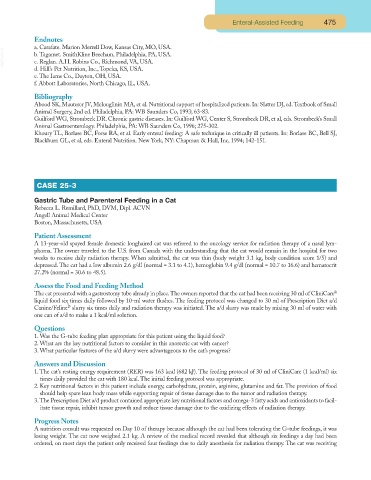Page 461 - Small Animal Clinical Nutrition 5th Edition
P. 461
Enteral-Assisted Feeding 475
Endnotes
a. Carafate. Marion Merrell Dow, Kansas City, MO, USA.
VetBooks.ir b. Tagamet. SmithKline Beecham, Philadelphia, PA, USA.
c. Reglan. A.H. Robins Co., Richmond, VA, USA.
d. Hill’s Pet Nutrition, Inc., Topeka, KS, USA.
e. The Iams Co., Dayton, OH, USA.
f. Abbott Laboratories, North Chicago, IL, USA.
Bibliography
Abood SK, Mauterer JV, Melouglinin MA, et al. Nutritional support of hospitalized patients. In: Slatter DJ, ed.Textbook of Small
Animal Surgery, 2nd ed. Philadelphia, PA: WB Saunders Co, 1993; 63-83.
Guilford WG, Strombeck DR. Chronic gastric diseases. In: Guilford WG, Center S, Strombeck DR, et al, eds. Strombeck’s Small
Animal Gastroenterology. Philadelphia, PA: WB Saunders Co, 1996; 275-302.
Khoury TL, Borlase BC, Forse RA, et al. Early enteral feeding: A safe technique in critically ill patients. In: Borlase BC, Bell SJ,
Blackburn GL, et al, eds. Enteral Nutrition. New York, NY: Chapman & Hall, Inc, 1994; 142-151.
CASE 25-3
Gastric Tube and Parenteral Feeding in a Cat
Rebecca L. Remillard, PhD, DVM, Dipl. ACVN
Angell Animal Medical Center
Boston, Massachusetts, USA
Patient Assessment
A 13-year-old spayed female domestic longhaired cat was referred to the oncology service for radiation therapy of a nasal lym-
phoma. The owner traveled to the U.S. from Canada with the understanding that the cat would remain in the hospital for two
weeks to receive daily radiation therapy. When admitted, the cat was thin (body weight 3.1 kg, body condition score 1/5) and
depressed. The cat had a low albumin 2.6 g/dl (normal = 3.1 to 4.1), hemoglobin 9.4 g/dl (normal = 10.7 to 16.6) and hematocrit
27.2% (normal = 30.6 to 48.5).
Assess the Food and Feeding Method
a
The cat presented with a gastrostomy tube already in place.The owners reported that the cat had been receiving 30 ml of CliniCare
liquid food six times daily followed by 10-ml water flushes. The feeding protocol was changed to 30 ml of Prescription Diet a/d
b
Canine/Feline slurry six times daily and radiation therapy was initiated. The a/d slurry was made by mixing 30 ml of water with
one can of a/d to make a 1 kcal/ml solution.
Questions
1. Was the G-tube feeding plan appropriate for this patient using the liquid food?
2. What are the key nutritional factors to consider in this anorectic cat with cancer?
3. What particular features of the a/d slurry were advantageous to the cat’s progress?
Answers and Discussion
1. The cat’s resting energy requirement (RER) was 163 kcal (682 kJ). The feeding protocol of 30 ml of CliniCare (1 kcal/ml) six
times daily provided the cat with 180 kcal. The initial feeding protocol was appropriate.
2. Key nutritional factors in this patient include energy, carbohydrate, protein, arginine, glutamine and fat. The provision of food
should help spare lean body mass while supporting repair of tissue damage due to the tumor and radiation therapy.
3. The Prescription Diet a/d product contained appropriate key nutritional factors and omega-3 fatty acids and antioxidants to facil-
itate tissue repair, inhibit tumor growth and reduce tissue damage due to the oxidizing effects of radiation therapy.
Progress Notes
A nutrition consult was requested on Day 10 of therapy because although the cat had been tolerating the G-tube feedings, it was
losing weight. The cat now weighed 2.1 kg. A review of the medical record revealed that although six feedings a day had been
ordered, on most days the patient only received four feedings due to daily anesthesia for radiation therapy. The cat was receiving

